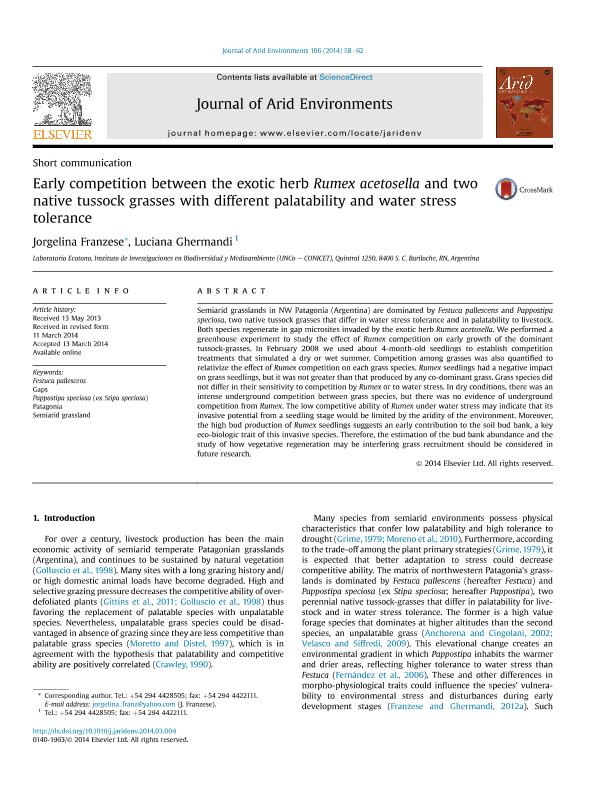Mostrar el registro sencillo del ítem
dc.contributor.author
Franzese, Jorgelina

dc.contributor.author
Ghermandi, Luciana

dc.date.available
2017-01-26T20:58:52Z
dc.date.issued
2014-07
dc.identifier.citation
Franzese, Jorgelina; Ghermandi, Luciana; Early competition between the exotic herb Rumex acetosella and two native tussock grasses with different palatability and water stress tolerance; Elsevier; Journal of Arid Environments; 106; 7-2014; 58-62
dc.identifier.issn
0140-1963
dc.identifier.uri
http://hdl.handle.net/11336/12052
dc.description.abstract
Semiarid grasslands in NW Patagonia (Argentina) are dominated by Festuca pallescens and Pappostipa speciosa, two native tussock grasses that differ in water stress tolerance and in palatability to livestock. Both species regenerate in gap microsites invaded by the exotic herb Rumex acetosella. We performed a greenhouse experiment to study the effect of Rumex competition on early growth of the dominant tussock-grasses. In February 2008 we used about 4-month-old seedlings to establish competition treatments that simulated a dry or wet summer. Competition among grasses was also quantified to relativize the effect of Rumex competition on each grass species. Rumex seedlings had a negative impact on grass seedlings, but it was not greater than that produced by any co-dominant grass. Grass species did not differ in their sensitivity to competition by Rumex or to water stress. In dry conditions, there was an intense underground competition between grass species, but there was no evidence of underground competition from Rumex. The low competitive ability of Rumex under water stress may indicate that its invasive potential from a seedling stage would be limited by the aridity of the environment. Moreover, the high bud production of Rumex seedlings suggests an early contribution to the soil bud bank, a key eco-biologic trait of this invasive species. Therefore, the estimation of the bud bank abundance and the study of how vegetative regeneration may be interfering grass recruitment should be considered in future research.
dc.format
application/pdf
dc.language.iso
eng
dc.publisher
Elsevier

dc.rights
info:eu-repo/semantics/openAccess
dc.rights.uri
https://creativecommons.org/licenses/by-nc-nd/2.5/ar/
dc.subject
Festuca Pallescens
dc.subject
Gaps
dc.subject
Pappostipa Speciosa
dc.subject
Patagonia
dc.subject
Semiarid Grassland
dc.subject.classification
Ecología

dc.subject.classification
Ciencias Biológicas

dc.subject.classification
CIENCIAS NATURALES Y EXACTAS

dc.title
Early competition between the exotic herb Rumex acetosella and two native tussock grasses with different palatability and water stress tolerance
dc.type
info:eu-repo/semantics/article
dc.type
info:ar-repo/semantics/artículo
dc.type
info:eu-repo/semantics/publishedVersion
dc.date.updated
2016-12-12T14:23:34Z
dc.journal.volume
106
dc.journal.pagination
58-62
dc.journal.pais
Países Bajos

dc.journal.ciudad
Ámsterdam
dc.description.fil
Fil: Franzese, Jorgelina. Consejo Nacional de Investigaciones Científicas y Técnicas. Centro Científico Tecnológico Patagonia Norte. Instituto de Investigación En Biodiversidad y Medioambiente; Argentina. Universidad Nacional del Comahue. Centro Regional Universitario Bariloche. Laboratorio de Ecotono; Argentina
dc.description.fil
Fil: Ghermandi, Luciana. Consejo Nacional de Investigaciones Científicas y Técnicas. Centro Científico Tecnológico Patagonia Norte. Instituto de Investigación en Biodiversidad y Medioambiente; Argentina. Universidad Nacional del Comahue. Centro Regional Universitario Bariloche. Laboratorio de Ecotono; Argentina
dc.journal.title
Journal of Arid Environments

dc.relation.alternativeid
info:eu-repo/semantics/altIdentifier/url/http://www.sciencedirect.com/science/article/pii/S0140196314000639
dc.relation.alternativeid
info:eu-repo/semantics/altIdentifier/url/http://dx.doi.org/10.1016/j.jaridenv.2014.03.004
Archivos asociados
